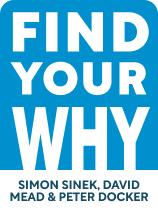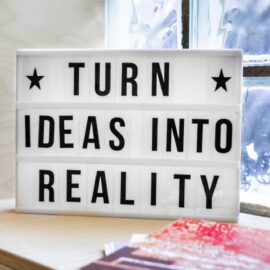

This article is an excerpt from the Shortform book guide to "Find Your Why" by Simon Sinek, David Mead, Peter Docker. Shortform has the world's best summaries and analyses of books you should be reading.
Like this article? Sign up for a free trial here .
How do you find meaning in your life when feeling unmotivated? How will your life improve once you discover your purpose?
According to author Simon Sinek, finding meaning in your life leads to discovering more satisfying work and making better decisions. Sinek’s “Golden Circle” technique for finding your life’s purpose can be used by anyone who desires a more meaningful life.
Keep reading to learn how to find meaning in your life by using Sinek’s proven technique, including a personal purpose exercise.
Finding Meaning in Your Life: How to Find Your Why
Finding your “Why” or purpose can help you make better choices in your work and life that lead to greater fulfillment, according to best-selling author Simon Sinek. That’s what he discovered when finding his purpose helped him overcome depression. He then began helping others find their purpose through his popular 2009 TED Talk and by working with individuals and organizations.
Sinek shared his ideas about the centrality of purpose in his best-selling book, Start With Why, in 2009, which focused on organizations. He outlined his theory that the most successful organizations have a clear purpose and stick to it as they grow. To provide practical help to more people, he later co-wrote Find Your Why with David Mead and Peter Docker: a follow-up book that lays out a step-by-step process for how to find meaning in your life by discovering your Why.
(Shortform note: Sinek’s concept of a Why or purpose isn’t new. In 1946, psychologist Viktor Frankl argued that the driving force in our lives is meaning, not pleasure or power, as other schools of thought at the time suggested. Frankl also argued that the meaning of life isn’t universal, but rather something each person must find for themselves, just as Sinek believes everyone has a unique purpose they must discover.)
Your Purpose Is at the Core of Everything You Do
We’ve discussed the importance of finding your purpose and its benefits. Next, we’ll explore how to find meaning in your life by using your purpose. We’ll start with a three-part model Sinek first introduced in Start With Why, which illustrates how having a central purpose affects your actions (your “How” or methods) and your results (“What” you accomplish).
Sinek’s “Golden Circle”
Sinek created the “Golden Circle” model to help you find meaning in your life by placing your day-to-day actions and your strengths in the context of your purpose, or Why. In other words, his model helps you see whether the action you’re taking aligns with your purpose and thus whether it will bring you fulfillment or distract you from your Why.
(Shortform note: In Designing Your Life, Bill Burnett and Dave Evans provide a similar tool: a Life Compass. It places your life and work philosophies side by side so you can identify where they overlap and determine whether your actions are in accord with your philosophies, or beliefs about what you do and why.)
Sinek’s model consists of three concentric circles. Each circle represents one of the core concepts in his theory.
1. The innermost circle is the Why: the purpose that orients everything you do. It’s the core belief that motivates you to get out of bed in the morning. In terms of an organization, it’s the mission you stand for and the reason you’re in business. An organization’s Why might be to provide accessible health care to its community. An individual’s Why might be to create spaces for learning.
2. The middle circle is the How: your typical methods and practices that characterize you, and which other people consider your strengths. Your How brings your Why to life. An organization’s How or method might be to always pursue the most sustainable alternatives. An individual’s How might be to forge meaningful connections.
3. The outermost circle is the What: the outputs or results you generate. It’s the tangible part of your organization or life and the easiest to identify. An organization’s What includes its products, services, policies, and strategies. An individual’s What might be their family, job, and projects.
The Purpose Discussion
To determine your Why and come up with a written statement, Sinek and his co-authors created a step-by-step process that individuals and groups can follow in a group discussion or workshop. Sinek’s process for learning how to find meaning in your life helps you or your team explore past experiences for insight into what moves you.
Get Into the Right Mindset
To bring the right mindset to the individual process, Sinek recommends that you:
1. Release preconceptions. Don’t expect or angle for a specific outcome. Instead, focus on telling your stories honestly, and let the process unfold. (Shortform note: This helps avoid confirmation bias—the tendency to interpret new information in a way that confirms what we already believe and one of the cognitive biases Daniel Kahneman discusses in Thinking, Fast and Slow. Confirmation bias might cause you to focus on stories that fit what you think your purpose should be, and overlook stories that don’t fit your expectations.)
2. Embrace vulnerability. The more honest and unguarded you are, the more useful this process will be. (Shortform note: If you’re hesitant about embracing vulnerability, keep in mind Brené Brown’s assertion in The Power of Vulnerability that vulnerability is a strength, as it requires more courage to share something intimate than to keep quiet for fear of being judged.)
Exercise: Discover Your Personal Purpose
If you don’t have the right partner available, these questions will help you through the process of finding your purpose on your own.
- Write down one of the stories you previously selected in as much detail as possible. Notice your emotions and physical responses as you write. When you notice an emotion, dig deeper—what is it about the story that’s triggering the emotion?
- Describe the main ideas and feelings in your story, the core action you took in the story, and the effect you had or tried to have. (Repeat this question and the previous one for each of the stories you picked for the process.)
- After you’ve worked through each story, look over your notes, and highlight recurring words or ideas. These are your themes. Identify two that you feel a strong connection to and convey your unique participation in the stories and your effect on others. Write them down.
- Write a statement using the two themes selected in the previous step. First, write the core action your purpose compels you to take. Second, write the ultimate impact you want that action to have. This is your purpose statement. (For example: “To tell necessary stories so that hurt people can heal,” or “To build strong foundations so that future generations can thrive.”)

———End of Preview———
Like what you just read? Read the rest of the world's best book summary and analysis of Simon Sinek, David Mead, Peter Docker's "Find Your Why" at Shortform .
Here's what you'll find in our full Find Your Why summary :
- Simon Sinek’s steps to understanding and living your purpose and your organization’s
- How to create and write your purpose statement
- What to do after you find your Why: Determine your How






